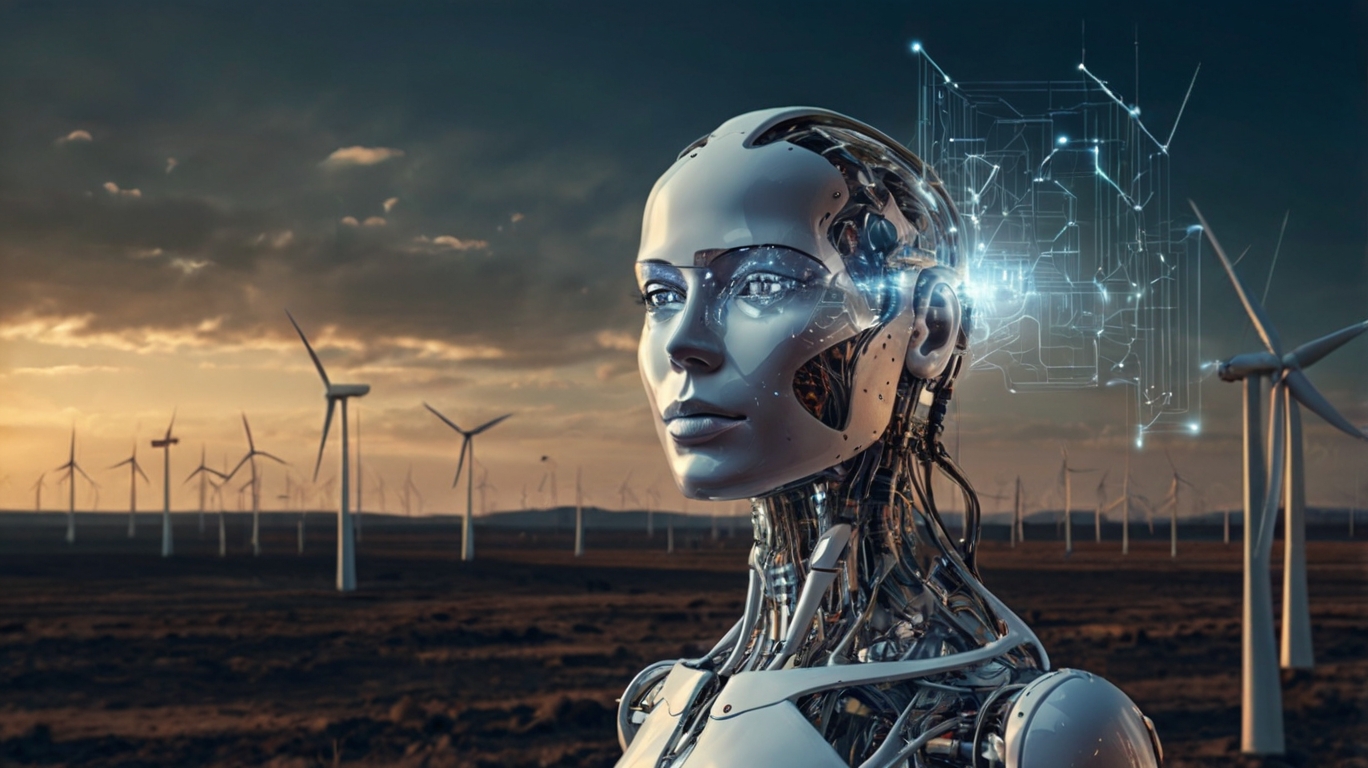As nations across the globe ramp up their commitments to combat climate change, renewable energy has moved from the periphery to the center of the world’s energy strategy. Solar, wind, hydro, and other renewable sources are rapidly replacing fossil fuels. However, one challenge remains constant: the intermittency and variability of renewable energy generation.
Unlike traditional power plants that produce energy in a stable and controllable manner, renewables are largely weather-dependent. The sun doesn’t always shine, and the wind doesn’t always blow. This variability creates uncertainty in energy supply, posing significant challenges for grid operators and energy markets.
This is where Artificial Intelligence (AI) has emerged as a game-changer. Through advanced data processing, predictive modeling, and machine learning, AI is transforming the way renewable energy is forecasted and managed. Across the globe, real-world implementations are proving that AI isn’t just theoretical—it’s making renewable energy smarter, more reliable, and more efficient.
Why Accurate Forecasting Matters
Energy grids require balance. The amount of electricity supplied must exactly match demand at all times. Overproduction leads to wasted energy and strain on infrastructure, while underproduction can cause blackouts and energy shortages. In a grid increasingly powered by fluctuating sources like wind and solar, forecasting accuracy becomes crucial.
Accurate forecasts allow grid operators to:
- Anticipate drops or spikes in generation.
- Schedule backup power from batteries or fossil plants.
- Avoid costly curtailments (when excess renewable energy is wasted).
- Optimize energy market trading and pricing.
Traditional statistical models often fall short due to the non-linear, chaotic nature of weather systems and energy consumption patterns. AI steps in to fill this gap with its ability to analyze vast and diverse datasets, learn from them, and make real-time predictions.
Key Technologies in AI Forecasting
AI encompasses a range of tools and techniques that are especially effective in forecasting applications, including:
- Machine Learning (ML): Algorithms that improve predictions by learning from historical data.
- Neural Networks: Deep learning systems that identify complex patterns in data such as cloud cover or wind speed.
- Reinforcement Learning: Algorithms that adapt and optimize predictions based on ongoing feedback.
- Natural Language Processing (NLP): Used for parsing and integrating weather reports and satellite data in various formats.
These technologies are often combined with satellite imagery, IoT sensor data, real-time weather feeds, and historical production records to create holistic and self-improving forecasting models.
Successful Real-World Implementations
1. Google DeepMind & the UK’s National Grid
In one of the most high-profile cases of AI in renewable energy, Google’s DeepMind partnered with the UK’s National Grid to enhance wind energy forecasting. By feeding weather forecasts and historical wind turbine data into deep neural networks, DeepMind increased forecast accuracy by nearly 20% for predictions made 36 hours in advance. This improvement significantly boosts the economic value of wind energy, allowing it to be scheduled more like traditional power.
2. IBM’s HyRef in China
IBM developed the Hybrid Renewable Energy Forecasting (HyRef) system to support China’s ambitious renewable goals. Deployed at major wind and solar farms, HyRef uses ML to process meteorological data, cloud movements, and terrain analytics. In one trial, it helped reduce energy curtailment by 35% and improved grid dispatch decisions. The technology has become a core part of China’s push to integrate renewable energy into its national grid.
3. India’s National Renewable Energy Forecasting Effort
India is one of the world’s largest renewable energy producers, with ambitious targets to reach 500 GW of non-fossil capacity by 2030. The National Institute of Wind Energy (NIWE), along with private technology firms, has introduced AI-driven models that incorporate real-time meteorological data, satellite images, and on-site sensors. These models feed into state-level Load Dispatch Centres (LDCs), helping them to stabilize the grid despite the fluctuating nature of wind and solar output.
4. Tesla’s Virtual Power Plant in Australia
In South Australia, Tesla has implemented a Virtual Power Plant (VPP) comprising thousands of homes equipped with solar panels and Powerwall batteries. AI is used to predict both energy production and household consumption, enabling dynamic load balancing and storage management. The system not only provides grid support but also reduces energy bills for participants. Early results show that the VPP can respond to grid demand faster than traditional power plants, thanks to AI’s predictive and real-time analytics capabilities.
Benefits Beyond Forecasting
While AI’s contribution to forecasting is revolutionary, its impact on the renewable energy sector goes far deeper. From grid optimization to energy trading, AI technologies are now interwoven into nearly every aspect of the energy value chain. These secondary benefits not only enhance operational efficiency but also improve economic performance, sustainability, and energy accessibility.
1. Grid Optimization and Real-Time Energy Management
As renewable penetration increases, maintaining a stable and resilient grid becomes more complex. AI-powered control systems are now central to managing this dynamic environment.
Dynamic Load Balancing: AI algorithms continuously analyze demand-supply data to maintain equilibrium across the grid, especially during peak hours or sudden drops in generation.
Smart Dispatching: AI enables faster, automated decisions on when to activate reserves or shift loads, improving the flexibility of the grid.
DER Integration: Distributed Energy Resources (e.g., rooftop solar, microgrids) are increasingly common. AI coordinates their output and storage to support the larger grid without overloads or instability.
Example: In Germany, AI-based grid systems help manage thousands of small-scale solar and wind installations that feed into the national grid, reducing reliance on centralized fossil fuel plants.
2. Battery Storage Optimization
Energy storage is key to mitigating the intermittency of renewables. AI enhances the performance and ROI of storage systems by managing when and how energy is stored or discharged.
Predictive Charging/Discharging: Based on price forecasts, consumption patterns, and weather data, AI determines the most economical time to use or store energy.
State-of-Charge (SoC) Estimation: AI provides more accurate insights into battery health and performance, ensuring safe and efficient operations.
Lifecycle Management: By avoiding overuse and optimizing charge cycles, AI extends battery lifespan and reduces replacement costs.
Example: AI systems in Tesla Powerwall networks or utility-scale batteries in California optimize the delivery of stored solar energy during evening peaks, helping flatten demand curves.
3. Predictive Maintenance of Renewable Assets
Maintenance of turbines, solar panels, and inverters is critical for uninterrupted renewable energy generation. AI-driven predictive maintenance minimizes downtime and reduces operational costs.
Failure Prediction: Using historical sensor data (temperature, vibration, etc.), AI models can forecast equipment failures before they happen.
Maintenance Scheduling: AI schedules repairs or component replacements based on usage patterns, weather forecasts, and technician availability, minimizing disruption.
Anomaly Detection: AI flags unusual behavior in machinery in real-time, allowing fast intervention before problems escalate.
Example: Wind farms in Denmark use AI-powered drones and image recognition to scan blades for cracks or ice buildup, reducing inspection times and preventing outages.
4. Renewable Energy Trading and Market Participation
In deregulated electricity markets, energy providers must decide when and how much energy to sell. AI makes trading smarter, faster, and more profitable.
Price Forecasting: AI models anticipate fluctuations in electricity prices based on generation forecasts, demand patterns, and grid conditions.
Automated Bidding: Algorithms can place bids in real-time markets autonomously, maximizing profits while complying with regulatory requirements.
Portfolio Optimization: AI helps energy providers manage diverse assets—solar, wind, storage, and demand response—to balance risk and return.
Example: In Europe’s day-ahead and intraday power markets, energy companies use AI-based trading bots to optimize renewable energy sales with millisecond-level precision.
5. Environmental and Social Benefits
Beyond the technical and financial gains, AI contributes to broader sustainability and equity goals.
Carbon Reduction: More efficient operation of renewable energy assets reduces fossil fuel dependency and lowers carbon emissions.
Energy Access: In developing countries, AI-powered microgrids enable localized energy solutions that bring power to remote or underserved communities.
Disaster Resilience: AI helps predict and respond to extreme weather events, ensuring that renewable systems stay online or recover quickly after disruptions.
Example: In sub-Saharan Africa, startups use AI to manage solar mini-grids that supply affordable electricity to off-grid villages, improving health, education, and economic outcomes.
Challenges and Limitations
Despite the progress, the adoption of AI in renewable forecasting still faces several challenges:
- Data Quality and Availability: AI models are only as good as the data they’re trained on. Inconsistent or low-resolution data can degrade forecast accuracy.
- Regulatory Barriers: In some regions, energy regulations have yet to fully accommodate AI-based operations.
- Integration Complexity: Legacy infrastructure may not be compatible with AI systems, requiring significant investment to upgrade.
- Cybersecurity Risks: As more grid functions become digitized, the risk of cyberattacks increases—highlighting the need for robust AI governance and security.
However, these challenges are being addressed through international collaborations, open data initiatives, and increasingly affordable cloud computing and sensor technologies.
The Future of AI in Renewable Energy
Looking forward, AI will continue to play an even more central role in energy systems:
- Autonomous energy systems that make independent decisions in real-time.
- Federated learning models that train across decentralized data sources without compromising privacy.
- Integrated energy AI platforms that connect forecasting, trading, maintenance, and grid management in a single ecosystem.
With advancements in quantum computing and edge AI, forecasting models could become even faster and more precise—paving the way for 100% renewable-powered grids.
Conclusion
AI has proven itself to be a vital enabler of the renewable energy transition. By unlocking more accurate forecasting and enabling smarter grid operations, AI is solving one of the most pressing challenges in clean energy adoption: variability. As these technologies continue to mature, we can expect a future where AI not only forecasts the weather—but powers the clean, sustainable world we are striving to build.




